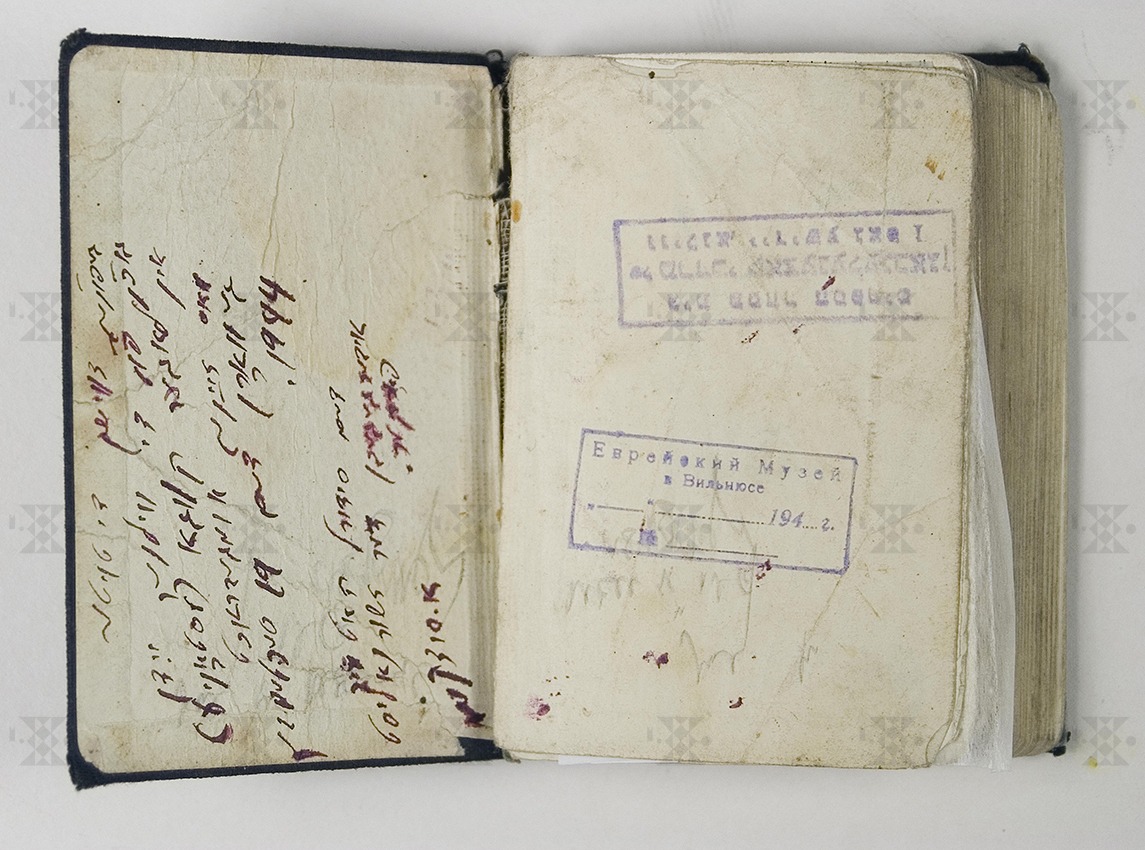The greatest value of the exhibits stored in the museum's collections sometimes lies not in the artefact itself, but in the marks left on it by the former custodian or owner. This is exactly the case with Sidur Hashalem, a daily prayerbook, published in Budapest. The prayerbook itself is not particularly different from other books of the kind, but the inscription and stamps in it tell us about the wanderings of this exhibit and the changing owners.
The inside of the cover incudes a handwritten inscription in Yiddish:
‘Found on 19 September 1944 in Kloga camp (Estonia) among the bodies of the murdered Jews of Vilnius.
The prayerbook was handed over by journalist Parker.
Avrom Sutzkever.
The author of the inscription is Avrom Sutzkever, one of the most famous Yiddish poets. Born in 1913 in Smurgainiai, Sutzkever spent his childhood years in Siberia, and at the age of nine moved to Vilnius together with his mother. There he took to writing and joined Yung Vilne (Young Vilnius), a modernist group of writers and artists. During the Holocaust, the poet was imprisoned in the Vilna Ghetto and was one of the members of the Paper Brigade that worked hard to save Jewish cultural heritage. Towards the end of the war, together with members of the United Partisan Organization (FPO) operating in the Vilna Ghetto, he escaped from the ghetto and joined the partisans in the forests of Belarus.
After World War II, Sutzkever returned to Vilnius and, together with other Holocaust survivors, tried to restore the life of the Jewish community. One of the members of the community was his long-time friend and poet Shmerke Kaczerginski, who also was member of the Paper Brigade during the Holocaust. Kaczerginski returned to Vilnius in the first days after the war and, as he later wrote in his memoirs, did not even notice how his legs took him directly to the YIVO institute building, which housed a hideout for the rescued Jewish cultural heritage. Unfortunately, a painful disappointment awaited him – the YIVO building was demolished and everything that was hidden in it was lost. However, members of the Paper Brigade hid the rescued cultural valuables in several places. The returnees hurried to inspect all of them and pull the preserved cultural valuables from the surviving hideouts. At first, all retrieved valuables would be taken to Sutzkever and Kaczerginski's apartment on Gedimino Ave., but soon the apartment appeared to be too small to host all of them. It was decided to establish a Jewish research institute to preserve the rescued collections and form new ones, primarily in an attempt to perpetuate Nazi crimes. On 26 August 1944, the Science Commission, which later became the Jewish Museum, started its activities. It operated for only a few years and in June 1949, in the heat of the Stalinist anti-Semitic campaign, was closed. The stamp in Russian found on the book reveals that it belonged to the post-war Jewish Museum.
The second visible stamp in Yiddish indicates that for some time the book was also part of Mordecai Katzenelenbogen’s personal library, who lived in Vilnius on Žydų St. 1. The prayerbook was published in Budapest, ended up in the personal library of a Vilnius resident who lived on Žydų St., accompanied its owner or another unknown reader to his death at the Kloga concentration camp, returned to Vilnius, where its wanderings were described by poet Sutzkever, and became part of the collection of the post-war Jewish Museum. Today the wanderings of the book are over and it makes part of the holdings of the Vilna Gaon Museum of Jewish History.
Prepared by Saulė Valiūnaitė, Head of Museum of Culture and Identity of Lithuanian Jews exposition.

